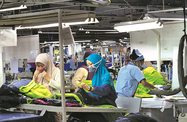Mongolia: Nurturing industry
Healthy growth in non-mining-related sectors of Mongolia’s economy and progress in plans for a multi-billion dollar industrial complex suggest the industry sector is on track towards contributing to the country’s goal of economic diversification.
The National Statistical Office (NSO) revealed on March 12 that in the first two months of 2012, total industrial output increased year-on-year by MNT20.6bn ($15.67m), or 7.7%, to MNT287.8bn ($218.86m). While this figure was dominated by an estimated 77.3% increase in output of mining and quarrying products, the light manufacturing sector also saw output rise.
In the same month, Prime Minister S. Batbold revealed that a release of bonds by the Development Bank would guarantee the estimated $10bn-14bn project costs for the Sainshand Industrial Complex (SIC). When completed in 2017, the SIC is expected to house a coal preparation plant, an oil refinery, copper, and iron and steel smelting plants, while a 1050-MW power plant at the complex will supply the vast Tavan Tolgoi and Oyu Tolgoi mines with power.
The SIC project fits in with government plans to ensure the country’s vast mineral resources drive broader industrial growth, rather than dominate the economy. As well, downstream processing will increasingly be carried out domestically rather than exporting raw products elsewhere. In the first 11 months of 2011, the manufacturing sector saw a 79.9% increase in the output of goods, such as bread, meat and wool, according to the NSO.
Key segments that have been identified for growth are the leather, cashmere and meat industries, all of which capitalise on the country’s traditional herding lifestyle, vast grazing expanses and geographical positioning between Russia and China. In an important step for the meat export industry, Mongolian agri-business firm Just Agro received the Hazard Analysis and Critical Control Points certification for its meat company, Makh Market, in February. This follows a major meat export deal signed with China last November for 8m sheep over the next three years and the resumption of sales to Russia after Moscow lifted a quarantine due to advances in Mongolia’s hygiene standards.
There are also signs of progress in the country’s cashmere sector, which currently earns around $180m annually and has the potential to supply 30% of global demand.
In December 2011, cashmere and garment group Gobi JSC – the fifth-largest cashmere producer in the world – announced it was investing in new equipment to improve the quality of its products and increase production capacity, thanks to a $5m loan from the European Bank for Reconstruction and Development (EBRD). It is estimated that improving the in-country domestic processing capacity could see yearly revenues rise to $480m-520m, and the industry-wide goal for 2012 is to turn at least 30% of raw cashmere into yarn domestically.
The EBRD assistance for Gobi JSC also follows moves by the Ministry of Finance in September 2011 to issue MNT300bn ($228.14m) worth of Mongolian bonds to support the wool and cashmere sector. Of the total to be raised, MNT150bn ($114.07m) will go toward developing small and medium-sized enterprises (SMEs), MNT100bn ($76.05m) will help support the producers of wool and cashmere products, and MNT50bn ($38.02m) will go to herders who sell camel and sheep wool to domestic factories.
“We are working to develop agro-processing industries, such as the processing of meat, milk, leather and other raw materials of agricultural origin, by introducing leading technologies and practices from foreign countries,” according to T. Badamjunai, the minister of food, agriculture, and light industry. “Products of livestock origin, such as cashmere, leather and meat, are best placed to compete internationally, while cashmere and leather products should do well in neighbouring markets. On top of that, all of Mongolia’s agricultural products are ecologically clean and are considered organic.”
Indeed, encouraging the growth of SMEs and developing sustainable products that encapsulate Mongolia’s appeal have been key facets of plans to reinvigorate the industrial sector. In 2009-10, MNT60bn ($46.8bn) in concessional loans were allocated to SMEs, and in 2011 loan support was further increased to MNT210bn ($163.8m).
As Mongolia develops a global brand with its light industry sector’s standout products, it will be better placed to use the revenues from mining to develop a more broad-based economy. In this regard, the SIC will become increasingly important, as will government efforts to support and subsidise growth in the wool and meat industries and to enable SMEs to expand and prosper.


